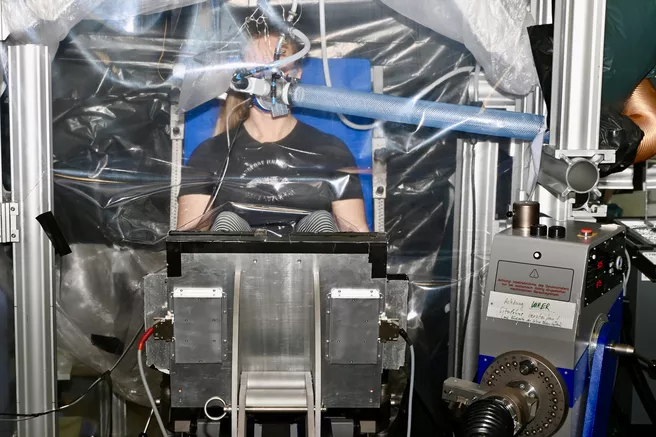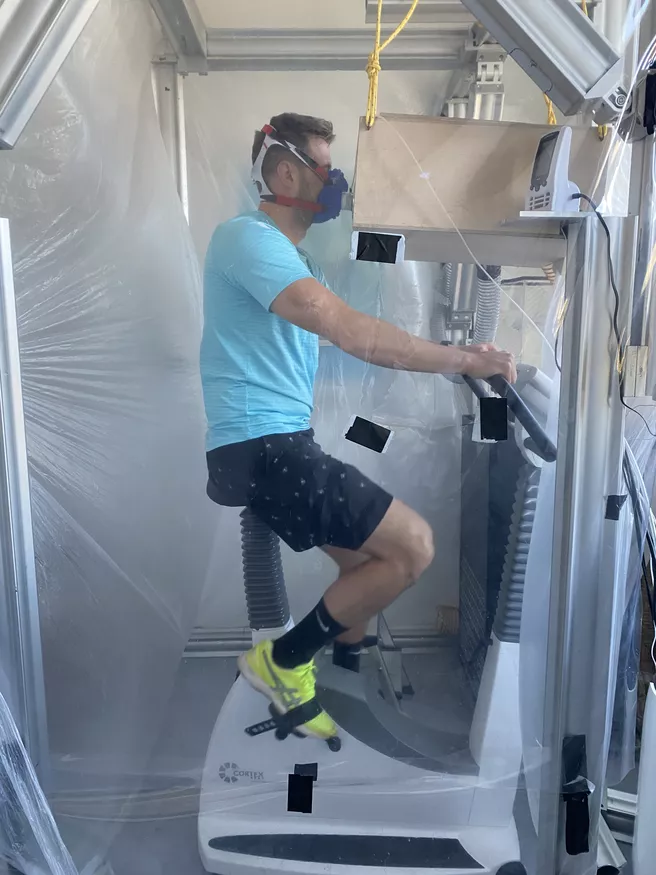Pathogens such as severe acute respiratory syndrome coronavirus type 2 (SARS-CoV-2), influenza or rhinoviruses are transmitted by aerosol particles in the air exhaled by infected persons. In a previous study, the Associate Professorship of Exercise Biology headed by Prof. Dr. Henning Wackerhage was already able to show that aerosol particle emission can increase exponentially by more than 100-fold during high physical exertion - and thus the risk of infection with infectious diseases such as corona also increases during indoor sports.
In a new study funded by the Federal Institute of Sport Science, the Associate Professorship of Exercise Biology, together with the Institute of Fluid Mechanics and Aerodynamics at the University of the Bundeswehr München, investigated how high the aerosol particle emission is during strength training compared to endurance training. For this purpose, isokinetic resistance exercises were performed at 80 percent of the maximum load, and test subjects completed either classic endurance training on spinning bikes or strength training with three exercises. In addition, it was calculated how high the risk of infection is for endurance sports compared to weight training. The results of the study have now been published under the title "Respiratory aerosol particle emission and simulated infection risk is greater during indoor endurance than resistance exercise" in the journal PNAS, which has an impact factor of 12.779.
"Infection prevention was an important issue in competitive sports even before the COVID-19 pandemic," explains Prof. Wackerhage, "and aerosol particle emission is a particular problem indoors. We therefore combined sports science research with top methods to obtain meaningful, but more importantly, quantifiable results. The method we used is currently the 'gold standard'. Based on the measurements of the increased output and the simulations, we were also able to quantify the increased risk of infection for the first time. The University of the Bundeswehr München, more specifically Dr. Benedikt Schumm and former TUM master's student Marie Heiber, contributed quite significantly to the success of the study."
As part of the research, ventilation as well as the emission of aerosol particles were measured simultaneously in three experimental groups, each with eight test subjects between the ages of 21 and 37, both during exertion and in rest phases, in order to calculate how many particles are emitted per minute.
"To make the measurements even more precise, the subjects also inhaled filtered air, so that we ultimately measured only those particles that were actually emitted by the participants," said Dr. Schumm, first author of the publication. "In doing so, we found that the concentration of aerosol particles reached similarly high levels in both exposures. However, there were load peaks in strength training, while endurance training produced sustained high levels of aerosol particles."
During isokinetic resistance training, aerosol particle emission increased tenfold from about 5,400 particles per minute at rest to about 59,000 particles per minute. When comparing realistic strength or endurance training sessions, aerosol particle emissions increased an average of 4.9-fold for endurance training compared to strength training. "In endurance sports, the emissions were fundamentally higher, and due to the participation of other test subjects in the spinning unit, these aerosol particles are in turn also inhaled in larger quantities, which is why this ultimately results in a 6-fold greater risk of infection than in weight training," explains Dr. Schumm.
The results of the study can now help to concretize recommendations for action both for indoor sports and for fitness studios. At times when many infections occur, for example, the main focus should be on increasing the air exchange rate in the facility or conducting high-intensity training sessions outdoors. In addition, architects can use this data when planning sports facilities.
To the publication „Respiratory aerosol particle emission and simulated infection risk is greater during indoor endurance than resistance exercise“ in the journal “PNAS”
To the homepage of the Associate Professorship of Exercise Biology
Contact:
Prof. Dr. Henning Wackerhage
Associate Professorship of Exercise Biology
Georg-Brauchle Ring 60/62
80992 München
phone: 089 289 24480
e-mail: Henning.Wackerhage(at)tum.de
Dr.-Ing. Benedikt Schumm
Institute of Fluid Mechanics and Aerodynamics
University of the Bundeswehr München
Werner-Heisenberg-Weg 39
85577 Neubiberg
phone: 089 6004 4687
e-mail: benedikt.schumm(at)unibw.de
Text: Romy Schwaiger
Photos: Associate Professorship of Exercise Biology/UniBW/private



